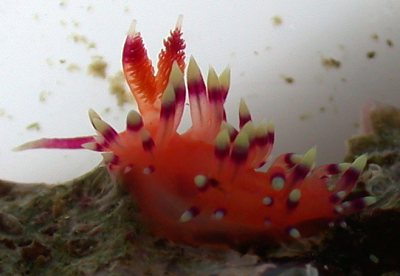
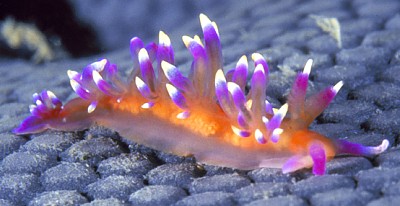
Flabellina marcusorum
Gosliner & Kuzirian, 1990
Order: NUDIBRANCHIA
Suborder: AEOLIDINA
Family: Flabellinidae
DISTRIBUTION
Two disjunct populations. One on the west coast of central America, the other from the Caribbean coast of South America to Brazil.
PHOTO
UPPER: Playa Mismaloya, Bahia de Banderas, 24 feet deep. Jalisco and Nayarit, Mexico [Pacific Coast]. March, 2002, 9 mm long. Photo: Alicia Hermosillo. LOWER: southern Brazil. Photo: Marcelo Krause.
The general body colour is a translucent pink or orange. The oral tentacles, foor corners, rhinophores and cerata are similarly coloured but have an opaque white tip, followed by a broad purplish band. The tip of the cerata may sometimes be opaque yellow rather than white. The rhinophores bear up to 100 papillae on the posterior face. Grows to 30mm long. Originally identified from both Brazil and the Gulf of California (Marcus & Marcus, 1961, 1970) as Coryphellina rubrolineata, this species has an extensive distribution from southern Brazil to the Caribbean, and in the eastern Pacific.
Compare with Flabellina arveloi, a recently described species from west Africa, which is very similarly coloured.
Reference:
• Gosliner, T.M. & Kuzirian, A.M. (1990) Two new species of Flabellinidae (Opisthobranchia: Aeolidacea) from Baja California. Proceedings of the California Academy of Sciences, 47(1): 1-15.
Rudman, W.B., 2000 (September 13) Flabellina marcusorum Gosliner & Kuzirian, 1990. [In] Sea Slug Forum. Australian Museum, Sydney. Available from http://www.seaslugforum.net/find/flabmarc
Related messages
Nudibranch from the Sea of Cortez
January 23, 2006
From: Renee Gallo
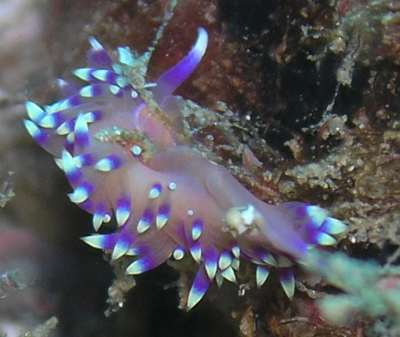
I saw this nudibranch in the Sea of Cortez near La Paz at a site called La Reinita. It's a small mount with currents moving accross it most of the time. It was about half an inch long.
Locality: La Reinita, Near La Paz, Baja California Sur, Mexico. Sea of Cortez. Depth: 20-30 ft. Length: 1/2 inch. 21 August 2005. rocky reef. Photographer: Renee Gallo
Renee Gallo
rgallo@mail.com
Renee Gallo, 2006 (Jan 23) Nudibranch from the Sea of Cortez. [Message in] Sea Slug Forum. Australian Museum, Sydney. Available from http://www.seaslugforum.net/find/15602Dear Renee,
Your beautiful aeolid is Flabellina marcusorum Gosliner & Kuzirian, 1990, named in honor of Ernst and Eveline du Bois-Reymond Marcus, for all the taxonomic work they did on opisthobranchs around the world. This species has been recorded from Isla Cedros to Panama, and the Galapagos on the Pacific Coast and also from the Caribbean, Colombia and Brazil, in the Atlantic.
Best wishes,
Dave Behrens
Flabellina marcusorum from the Bahamas
June 17, 2005
From: Phillip Gillette
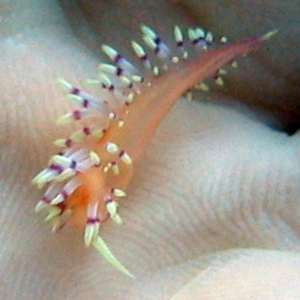
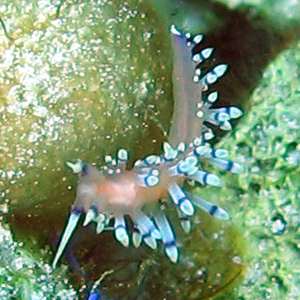
Hi,
I have an ID question. I found this nudibranch in the water column near the surface on a dive in the Northern Exumas, Bahamas. it seems to be the nudibranch Paul Humann describes as the Purple-Ring Nudibranch, which he says has only been found in Belize. I was just curious as to which species it is.
Locality: Baracuda Schoals, Exumas Ids, Bahamas, Caribbean. Length: 1 cm. May 2005. Photographer: Philip Gillette
Phillip Gillette
pgillette1@hotmail.com
Gillette, P, 2005 (Jun 17) Flabellina marcusorum from the Bahamas. [Message in] Sea Slug Forum. Australian Museum, Sydney. Available from http://www.seaslugforum.net/find/14042Dear Phillip,
It's name is Flabellina marcusorum. It is known from both the Pacific and Atlantic coasts of tropical America and down to Brazil. There are quite a few reords on the Forum of this species.
Best wishes,
Bill Rudman
Flabellina marcusorum from The Sea of Cortez
September 23, 2003
From: Marli Wakeling
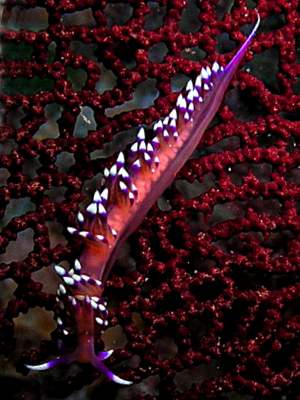
Hi Bill,
A friend just returned from the Sea of Cortez [Gulf of California] with some interesting shots. I believe this is Flabellina marcusorum
Date: September 2003
Photo: Rand McMein
scubamarli@excite.com
Wakeling, M., 2003 (Sep 23) Flabellina marcusorum from The Sea of Cortez. [Message in] Sea Slug Forum. Australian Museum, Sydney. Available from http://www.seaslugforum.net/find/10991Thanks Marli,
I think your identification is correct, but I would like to see the shape of the rhinophores before I was 100% sure
Best wishes
Bill Rudman
Re: Flabellina marcusorum from nthn Bahamas
September 12, 2003
From: Lazaro Ruda
Dear Dr Rudman,
Thank you very much for the information. The reef where I found this nudibranch is known by the name of Deep Snapper Ledges in what is considered "Middle Shoal" near Mantanilla Shoal. The closest dry land is the West End -- approx. 30-35 miles.
Lazaro Ruda
laz@thelivingsea.com
Ruda, L., 2003 (Sep 12) Re: Flabellina marcusorum from nthn Bahamas. [Message in] Sea Slug Forum. Australian Museum, Sydney. Available from http://www.seaslugforum.net/find/10952Thanks Lazaro,
Good locality data makes your photo a valuable record about this species. We know so little about the Caribbean fauna, that any additional bit of information is very valuable
Best wishes
Bill Rudman
Flabellina marcusorum from nthn Bahamas
September 1, 2003
From: Lazaro Ruda
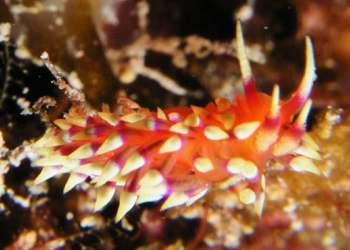
Dr. Rudman,
On a recent trip to the northern Bahamas islands, I found this nudibranch that according to Paul Humann & Ned Deloach's Reef Creature ID book states it to be the 'Purple-Ring Nudibranch' (Flabellina sp.). I was hoping you could verify that my identification was correct and if so, there's mention in the ID book that it has only been found in Belize. Has there been any other sightings of this creature further north?
The nudibranch was approx. 1/2 inch long. I found it traveling (feeding?) along some Y Branched Algae (Dictyota sp.). This critter was photographed at 34ft. at 6:30PM EST on the shallow overhang of a low profile reef system near a sandy area.
Lazaro Ruda
laz@thelivingsea.com
Ruda, L., 2003 (Sep 1) Flabellina marcusorum from nthn Bahamas. [Message in] Sea Slug Forum. Australian Museum, Sydney. Available from http://www.seaslugforum.net/find/10867Note added Sept 12 2003: 'The reef where I found this nudibranch is known by the name of Deep Snapper Ledges in what is considered "Middle Shoal" near Mantanilla Shoal. The closest dry land is the West End -- approx. 30-35 miles'.. Lazaro Ruda
Dear Lazaro,
It's name is Flabellina marcusorum. It has quite a wide distribution [see Fact Sheet], but our knowledge is based on very few records, so yours from the Bahamas is a useful addition. perhaps you can give us the name of an island or reef to add to the data? Concerniing feeding, all species of Flabellina feed on hydroids.
Best wishes,
Bill Rudman
Flabellina marcusorum from Tobago, West Indies
August 15, 2003
From: Solomon Baksh
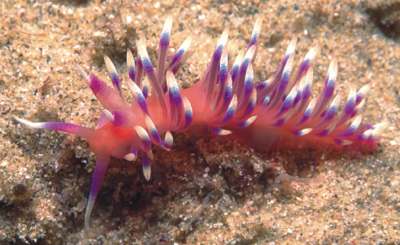
This image as taken in Tobago, West Indies.
Size: 1.5 cm
Paul Humann said that the species closely related to the blue streak nudibranch but may be an entirely new species.
Can you please help identify this species of nudibranch.
Solomon Baksh
chromis@tstt.net.tt
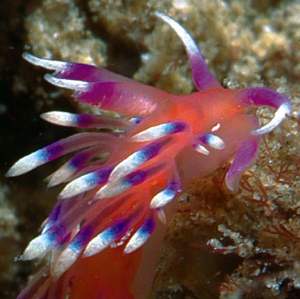

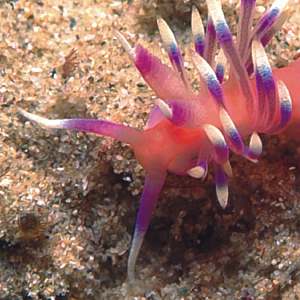
Dear Solomon,
Luckily I have just received from Paul Humann a copy the Enlarged 2nd Edition of his Reef Creature Identification - Florida Caribbean Bahamas which he has written with Ned Deloach. I will prepare a review to update the existing review when I get a moment.
Armed with this book I can identify what you mean by the 'Blue Streak Nudibranch'. Your animal is in fact the next one down page 305 which Humann & Deloach identify as Flabellina sp. It is Flabellina marcusorum. I have included a close-up of the head alongside to show the papillate rhinophores. This species is known from only a few records so your find is an important addition to our knowledge. Humann & Deloach's photo is from Belize, which is another new record.
• Humann, P. & Deloach, N. (2002) Reef Creature Identification - Florida Caribbean Bahamas. 2nd Edition. 420pp. New World Publications: Jacksonville.
Best wishes,
Bill Rudman
Re: Unidentified aeolid from Brazil
December 17, 2002
From: Dave Behrens
Bill:
Marcelo's animal animal from southern Brazil is Flabellina marcusorum Gosliner & Kuzirian 1990.
Dave Behrens
dave@seachallengers.com
Behrens, D., 2002 (Dec 17) Re: Unidentified aeolid from Brazil. [Message in] Sea Slug Forum. Australian Museum, Sydney. Available from http://www.seaslugforum.net/find/8675Thanks Dave,
I should have looked at the species described from the east Pacific. These disjunct distributions on both sides of the Panama Isthmus are a bit of a trap.
Cheers,
Bill
Unidentified aeolid from Brazil
December 14, 2002
From: Marcelo Krause

Hello,
This picture is a nudibranch on a diver's glove which I photgraphed in the south of Brazil. In 15 years of diving here this is the only time I saw this species at about 14m depth.
Thank you,
Marcelo
marcelo@underwater.com.br
Krause, M., 2002 (Dec 14) Unidentified aeolid from Brazil. [Message in] Sea Slug Forum. Australian Museum, Sydney. Available from http://www.seaslugforum.net/find/8575Dear Marcelo,
I am sorry but this one is not as easy as your last photo. It is an aeolid nudibranch, and most probably a glaucid or flabellinid. I have looked through the relevant literature without success. It is possibly an unnamed species. Hopefully someone with a personal knowledge of the west Atlantic fauna will be able to help identify this
Bst wishes,
Bill Rudman
Flabellina marcusorum from Mexico
April 5, 2002
From: Alicia Hermosillo

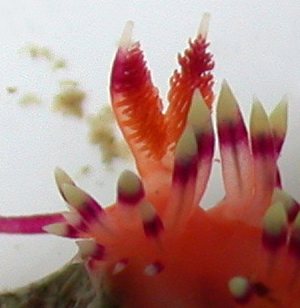
Dear Bill,
Here is a photo of Flabellina marcusorum from 24 feet deep in Playa Mismaloya, Bahia de Banderas, states of Jalisco and Nayarit, Mexico [Pacific coast]. March, 2002
9 mm long.
This particular picture shows very clearly the structure of the rhinophores.
Alicia
gueri25@hotmail.com
Hermosillo, A., 2002 (Apr 5) Flabellina marcusorum from Mexico. [Message in] Sea Slug Forum. Australian Museum, Sydney. Available from http://www.seaslugforum.net/find/6547Dear Ali,
Thanks very much. This is a much more colourful example than Phanor's animal from the Caribbean coast of Colombia. It has colour similarities to the sympatric Flabellina telja, but that species had lamellate rhinophores.
Best wishes,
Bill Rudman
Re: Flabellina from Columbia
September 14, 2000
From: Sandra Millen
The Flabellina from Colombia sent in by Phanor Montoya is Flabellina marcusorum Gosliner & Kuzirian, 1990. This animal has papillate rhinophores and violet purple markings on a light body. It has been found in Brazil as well as on the Pacific coast of Mexico and the Gulf of California.
Sandra Millen
millen@zoology.ubc.ca
Millen, S., 2000 (Sep 14) Re: Flabellina from Columbia. [Message in] Sea Slug Forum. Australian Museum, Sydney. Available from http://www.seaslugforum.net/find/3019Thanks Sandra,
Bill Rudman.
Flabellina marcusorum from Colombia
September 14, 2000
From: Terry Gosliner
Dear Bill,
I hope you have Olympic fever. I wanted to let you know that Phanor's Flabellina is F. marcusorum, which Alan Kuzirian and I described in 1990. It is a member of the same clade as F. rubrolineata , F. exoptata, F. poenicia, F. delicata and F. hamanni, all of which have papillate rhinophores. It has been found on both sides of the American continent and we have not been able to find any anatomical differences that separate the two populations despite 3.5 million years of separation.
All the best,
Terry.
tgosline@calacademy.org
Gosliner, T., 2000 (Sep 14) Flabellina marcusorum from Colombia. [Message in] Sea Slug Forum. Australian Museum, Sydney. Available from http://www.seaslugforum.net/find/3021Dear Terry,
I don't know if your Olympic inquiry was in the nature of a curse or a blessing. I left work early today to try and avoid the growing chaos on the trains and 10 minutes ago the Olympic Torch Relay went past my house. Some have left Sydney until it is all over, some are becoming more proud and excited every day and many of us hold mixed emotions. We hope that it will all go well, are shocked by the many excesses, and hope that we will still be able to get to work. If the public transport system fails I am fortunate that I will be able to work at home. As long as the internet does not become clogged with olympic business I may even be able to make an inroad into the backlog of messages I have on the Forum.
And by the way, thanks for identifying Phanor's Flabellina.
Best wishes,
Bill Rudman.
Flabellina telja? from Colombia
September 12, 2000
From: Phanor Montoya
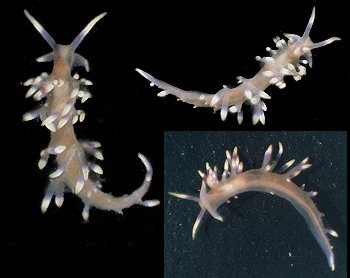
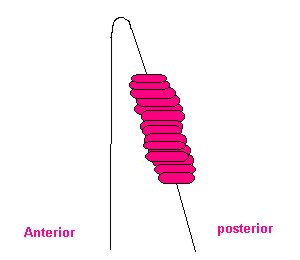
Dear Bill,
I found this nudibranch walking on a rock in a reef zone from the Santa Marta Bay (Colombia - Caribbean coast); depth 30ft. The body was 12mm in long and 2mm wide. I looked on the internet and found a picture of Flabellina telja, and the animal on my pictured looks very similar to that one, so I guess is the same species; am I right?
I don`t have a better picture, but I do remember that the rhinophores had violet papilles at the posterior side of them. I draw a sketch of one rhinophore with its papilles, I know it`s not as good as a picture but I hope it`d help you to identify my nudibranch!
Phanor Montoya
phamont@eudoramail.com
Montoya, P., 2000 (Sep 12) Flabellina telja? from Colombia. [Message in] Sea Slug Forum. Australian Museum, Sydney. Available from http://www.seaslugforum.net/find/2975Dear Phanor,
I'm not an expert on the fauna of that region but two things seem to be against your identification. Firstly F. telja is known from the west (East Pacific) coast, and it has lamellate rhinophores, not papillate ones as you have drawn.
There are three species of Flabellina I know of from the Caribbean:
•Flabellina engeli Marcus, 1968 [Curacao, Colombia, Florida (Marcus 1977)] •Coryphella dushia Marcus, 1963 [Curacao]
•Flabellina sp. 2 [in Forum]
F. dushia was described as being white, with no distinguishing colour features, and smooth rhinophores, but at 5mm long the 3 specimens may have been juveniles which had not developed adult characters.
F. engeli was described as having lamellate rhinophores, and a transparent pinkish white body with scarce brown pigment granules. Other features include: cerata light brown, each with darker brown ring. Opaque white spot between tentacles, one on each side behind them, streaks and spots between the ceratal bases dorsomedial stripe along tail approx 20mm.
Neither of these species nor Flabellina sp. 2 would seem to match your animals. It seems to be a species of Flabellina. Perhaps someone with a knowledge of the Caribbean fauna can help.
Best wishes,
Bill Rudman.
